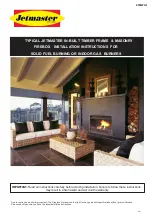
13
NOTE: DIAGRAMS & ILLUSTRATIONS ARE NOT TO SCALE.
Place the insert into the fireplace, making sure to center it side to side.
Slide the insert in until the surround mounts are approximately 1/2” (13
mm) from the face of the fireplace where the surround panels cover.
Lower the chimney and make attachment to the insert. Level the fireplace
insert by using a 3/4” socket and a long extension and adjusting the bolts
on either side of the insert.
Install the side surround panels with the screws supplied. Push the insert
in until there is approximately a 1/4” (6 mm) gap between the back of the
surround panels and the face of the fireplace. Before installing the top
surround panel, make sure all connections are tight and that no part of
the insert or chimney is touching the firebox or chimney in the fireplace.
There must be a minimum of 1” (25mm) clearance between the fireplace
insert and the zero clearance fireplace. Install the top surround panel.
If additional support is necessary, factory punched holes in the front
corners of the bottom air chamber will accept leveling legs. Carefully
measure the distance from the hearth protection to the bottom of the
fireplace insert. Use 3/8” diameter bolts that are 1/2” (13 mm) longer than
the distance just measured. Thread a nut onto the bolt approximately 1”
(25 mm). Lift the fireplace insert slightly and insert a bolt into each hole
and then thread the nut up the bolt until the front is securely supported.
Install another nut onto the bolt through the air space in the fireplace insert
and tighten securely. If desired an insert front support, Part# H5296, is
available to fill the space between the insert and the hearth protection.
Install the brick and baffle as per
Page 7
.
CHIMNEY LINER INSTALLATION
INSTALLING THE INSERT
POST INSTALLATION CHECKS
Remove the existing chimney cap and install a stainless steel liner into
the chimney (if a special section has been used or drilled to attach to the
insert, it must be the bottom piece). The next piece should be a dripless
slip joint, followed by the rest of the chimney liner. Fasten the chimney
at the top when it is positioned so that the slip joint will allow the lowest
piece to slide up enough to clear the insert during installation. Insulate
the top four to six feet between the liner and the chimney to prevent heat
loss. Install the cap and flash if necessary to prevent water or creosote
from entering the chimney’s venting system.
From inside the fireplace firebox, attach any adaptors or flue offsets and
slide the liner up as far as necessary for the bottom piece to clear the
insert during installation.
In Canada, This fireplace insert must be installed with a continuous chimney
liner of 6” diameter extending from the fireplace insert to the top of the
chimney. The chimney liner must conform to the Class 3 requirements
of CAN/ULC-S635, Standard for Lining Systems for Existing Masonry
or Factory-Built Chimneys and Vents, or CAN/ULC S640, Standard for
Lining Systems for New Masonry Chimneys.
1. Check that all chimney pipe joints are securely fastened.
2. Be sure all roof flashings are watertight (if applicable).
FOR YOUR OWN PROTECTION AND INSURANCE PURPOSES,
HAVE YOUR CHIMNEY AND CONNECTOR PIPE INSTALLATION
INSPECTED BY YOUR LOCAL BUILDING CODE AUTHORITY OR
FIRE MARSHAL BEFORE STARTING A FIRE IN YOUR STOVE OR
INSERT. NOTIFY YOUR INSURANCE COMPANY.












































